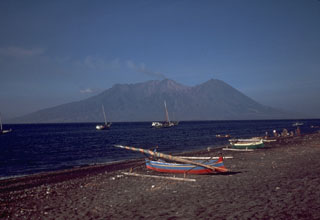Report on Sangeang Api (Indonesia) — 10 October-16 October 2012
Smithsonian Institution / US Geological Survey
Weekly Volcanic Activity Report, 10 October-16 October 2012
Managing Editor: Sally Sennert.
Please cite this report as:
Global Volcanism Program, 2012. Report on Sangeang Api (Indonesia) (Sennert, S, ed.). Weekly Volcanic Activity Report, 10 October-16 October 2012. Smithsonian Institution and US Geological Survey.
Sangeang Api
Indonesia
8.2°S, 119.07°E; summit elev. 1912 m
All times are local (unless otherwise noted)
CVGHM reported that during 1-10 October Sangeang Api was often not visible due to fog; occasionally plumes were visible and rose as high as 20 m above the crater. The lava dome and surrounding areas had not changed compared to the beginning of the year. Both the number and magnitude of earthquakes increased on 5 October, declined during 6-8 October, then again increased on 9 October. The Alert Level was raised to 3 (on a scale of 1-4) on 10 October.
Geological Summary. Sangeang Api volcano, one of the most active in the Lesser Sunda Islands, forms a small 13-km-wide island off the NE coast of Sumbawa Island. Two large trachybasaltic-to-tranchyandesitic volcanic cones, Doro Api and Doro Mantoi, were constructed in the center and on the eastern rim, respectively, of an older, largely obscured caldera. Flank vents occur on the south side of Doro Mantoi and near the northern coast. Intermittent eruptions have been recorded since 1512, most of them during in the 20th century.
Source: Pusat Vulkanologi dan Mitigasi Bencana Geologi (PVMBG, also known as CVGHM)

